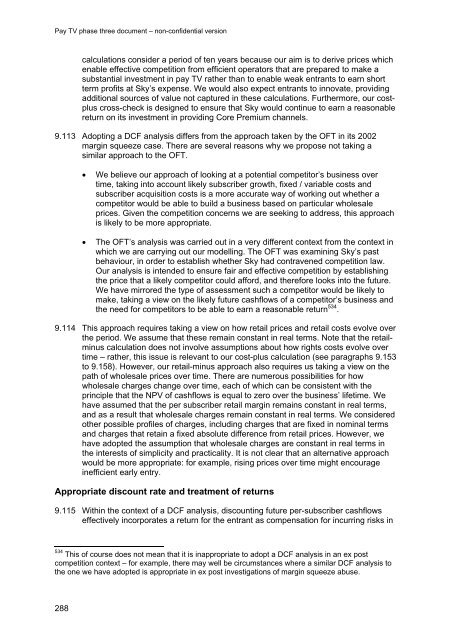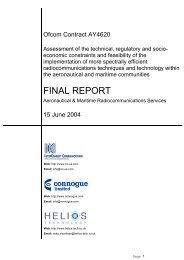Pay TV phase three document - Stakeholders - Ofcom
Pay TV phase three document - Stakeholders - Ofcom
Pay TV phase three document - Stakeholders - Ofcom
You also want an ePaper? Increase the reach of your titles
YUMPU automatically turns print PDFs into web optimized ePapers that Google loves.
<strong>Pay</strong> <strong>TV</strong> <strong>phase</strong> <strong>three</strong> <strong>document</strong> – non-confidential version<br />
288<br />
calculations consider a period of ten years because our aim is to derive prices which<br />
enable effective competition from efficient operators that are prepared to make a<br />
substantial investment in pay <strong>TV</strong> rather than to enable weak entrants to earn short<br />
term profits at Sky’s expense. We would also expect entrants to innovate, providing<br />
additional sources of value not captured in these calculations. Furthermore, our costplus<br />
cross-check is designed to ensure that Sky would continue to earn a reasonable<br />
return on its investment in providing Core Premium channels.<br />
9.113 Adopting a DCF analysis differs from the approach taken by the OFT in its 2002<br />
margin squeeze case. There are several reasons why we propose not taking a<br />
similar approach to the OFT.<br />
� We believe our approach of looking at a potential competitor’s business over<br />
time, taking into account likely subscriber growth, fixed / variable costs and<br />
subscriber acquisition costs is a more accurate way of working out whether a<br />
competitor would be able to build a business based on particular wholesale<br />
prices. Given the competition concerns we are seeking to address, this approach<br />
is likely to be more appropriate.<br />
� The OFT’s analysis was carried out in a very different context from the context in<br />
which we are carrying out our modelling. The OFT was examining Sky’s past<br />
behaviour, in order to establish whether Sky had contravened competition law.<br />
Our analysis is intended to ensure fair and effective competition by establishing<br />
the price that a likely competitor could afford, and therefore looks into the future.<br />
We have mirrored the type of assessment such a competitor would be likely to<br />
make, taking a view on the likely future cashflows of a competitor’s business and<br />
the need for competitors to be able to earn a reasonable return 534 .<br />
9.114 This approach requires taking a view on how retail prices and retail costs evolve over<br />
the period. We assume that these remain constant in real terms. Note that the retailminus<br />
calculation does not involve assumptions about how rights costs evolve over<br />
time – rather, this issue is relevant to our cost-plus calculation (see paragraphs 9.153<br />
to 9.158). However, our retail-minus approach also requires us taking a view on the<br />
path of wholesale prices over time. There are numerous possibilities for how<br />
wholesale charges change over time, each of which can be consistent with the<br />
principle that the NPV of cashflows is equal to zero over the business’ lifetime. We<br />
have assumed that the per subscriber retail margin remains constant in real terms,<br />
and as a result that wholesale charges remain constant in real terms. We considered<br />
other possible profiles of charges, including charges that are fixed in nominal terms<br />
and charges that retain a fixed absolute difference from retail prices. However, we<br />
have adopted the assumption that wholesale charges are constant in real terms in<br />
the interests of simplicity and practicality. It is not clear that an alternative approach<br />
would be more appropriate: for example, rising prices over time might encourage<br />
inefficient early entry.<br />
Appropriate discount rate and treatment of returns<br />
9.115 Within the context of a DCF analysis, discounting future per-subscriber cashflows<br />
effectively incorporates a return for the entrant as compensation for incurring risks in<br />
534 This of course does not mean that it is inappropriate to adopt a DCF analysis in an ex post<br />
competition context – for example, there may well be circumstances where a similar DCF analysis to<br />
the one we have adopted is appropriate in ex post investigations of margin squeeze abuse.
















